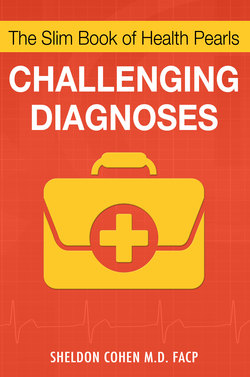Читать книгу The Slim Book of Health Pearls: Challenging Diagnoses - Sheldon Cohen - Страница 4
На сайте Литреса книга снята с продажи.
IMMUNE SYSTEM
ОглавлениеWith that in mind, we will first discuss the immune system, the story of the body’s defenses; how the body confronts enemies trying to do us harm. This short story will provide a better understanding of the amazing way this life and death struggle takes place. It is a coordinated system combining the beauty of organs, cells, and complicated collections of proteins working in a harmonious manner for the good of the whole. There are various lines of defense used to keep us alive in a world where invisible or visible predators attack us minute by minute. Besides the foreign substances that can invade us as mentioned above (bacteria viruses, fungi and parasites), we must also include pollen, cancer cells, and internal body cell changes arising spontaneously; the pollen invading us from the outside, the cancer cells invading us from within, the internal body changes arising spontaneously—now all considered foreign and subject to an all-out assault by the immune system.
Getting right down to the details of the immune response, let me advise that the principle mechanism of our specific immune response is carried out by two members of the white blood cell team known as T lymphocytes and B lymphocytes. These two types of white blood cells circulate in our blood stream and position themselves in body tissues by the billions. Their job is to:
•Identify body cells (self) that have changed, thus the lymphocytes do not identify them as belonging to the body, but rather view them as non-self—and attack.
•Identify invaders of the body that certainly do not belong (non-self)—and attack.
In other words, lymphocytes differentiate self from non-self—and anything non-self is eliminated (killed). How do they do this?
All body cells carry distinctive molecules (epitopes) on their surfaces that identify it as self. Our specific immune cells, (lymphocytes), recognizing this self-marker, coexist in a peaceful state known as self-tolerance. Failure to recognize this body self-marker as self, launches a vigorous attack by lymphocytes. What are these immune cells (B cells, T cells)?
Before we get into this very specific line of defense where B cells and T cells attack specific invaders, understand that there is also a mechanism constituting a first line of defense categorized as nonspecific body defenses because they are not programmed to zero in on specific targets like our lymphocytes do, but rather “kill ‘em all.”
As this non-specific line of defense is different from the B and T cells, I have placed them in an appendix so as not to disrupt the story of the specific line of defense. The reader has the choice to read it now or save it for after completing the book. (SEE APPENDIX 1
The red bone marrow is where all blood cells are manufactured including the B cells or B lymphocytes, and T cells or T lymphocytes constituting the specific line of defense. The thymus gland is responsible for putting the final touches on the T cells, producing functioning T cells, or T lymphocytes. Again, these B and T cells are the lymphocytes that are responsible for the specific immune responses.
The red bone marrow where B cells and T cells are produced is also the site of production for all the other cellular elements of the blood including:
1.Red blood cells
2.All the other various types of white blood cells (4) besides the B&T lymphocytes.
3.Blood platelets—important in blood coagulation.
Red bone marrow in adults is located in flat bones (sternum) and in the epiphysis (the end of long bones).
Within the red bone marrow is a stem cell known as a hemocytoblast. Hemo, from the Greek haima (blood), cyto (cells), blast, from the Greek blastos, sprout. This precursor stem cell evolves (sprouts) into two other cells:
•lymphoid stem cell that forms B & T lymphocytes.
•myeloid stem cell that forms the red blood cell, the platelets, and four different white blood cells, the basophil, the eosinophil, the neutrophil, and the monocyte.
These white cells arising from the myeloid stem cell precursors are called leucocytes or white blood cells (from the Greek, leuco white). The latter four are involved in the non-specific system of defense. Again, SEE APPENDIX ONE.
1.The basophil is the rarest of the white blood cells. Filled with histamine granules, it dilates blood vessels and makes them more permeable. In addition, it is one of the agents responsible for attracting other white blood cells to action.
2.The eosinophils increase in number and rally to the cause during infection by parasites, and in response to allergens (any substance that can cause an allergy).
3.The neutrophils are actively involved in phagocytosis (ingesting and digesting bacteria). They have a ravenous appetite for invading bacteria.
4.The monocytes are the largest of all the white blood cells and they change into macrophages when they migrate into tissues from the blood stream. Macrophages have an appetite for bacteria that can cause long standing chronic infections such as tuberculosis.
